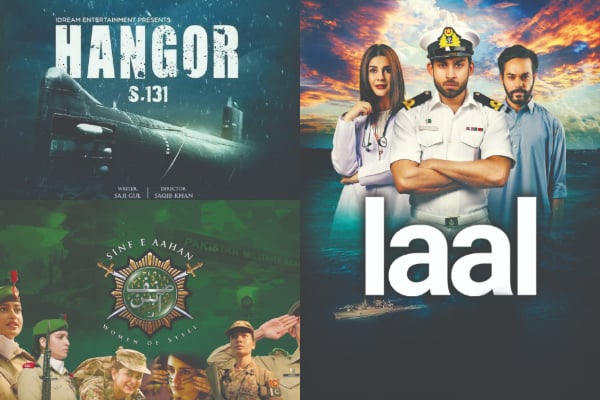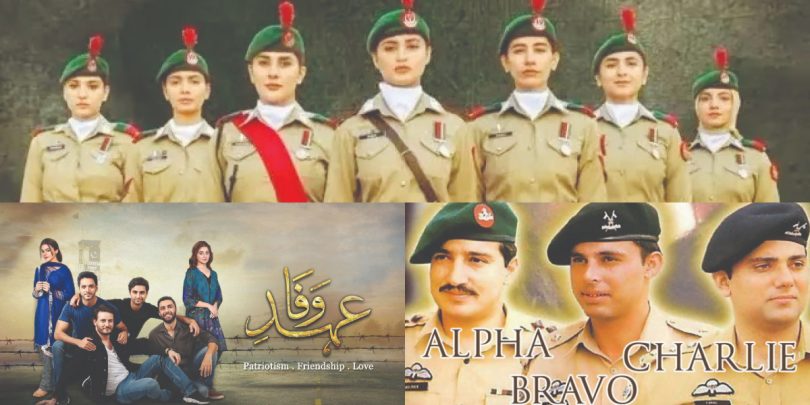Synopsis
As March 23rd is just around the corner, let’s move into the patriotic gear and take a trip down memory lane
Pakistani drama industry is at a very interesting juncture at the moment; most of the makers aren’t ready for new content, whereas the audience loves whenever something new becomes a part of their watchlist. However, the one constant element that hasn’t disappointed ever has been ‘patriotic dramas’, which have been around for over 40 years, and are going strong with Sinf-e-Aahan currently on-air.
Although the female wing of the Armed Forces was once touched in Ek Thi Marium, Sinfe-e-Aahan is making both the women and the Pakistan Army proud. Let’s take a trip back in time and find out how dramas revolving around the Armed Forces of Pakistan gave the makers confidence to delve into this certain genre and come up with such interesting projects that are still remembered even after 4 decades.

It all began with Nishan-e-Haider
Compared to Pakistan’s neighbours especially the ones on the East, Pakistan Television evolved from a newbie to a major force to reckon with in no time. At first, most of the TV dramas were adapted versions of literary classics, but when PTV stepped into the original domain in the mid-70s, they did everything right. Director Kunwar Aftab Ahmed was the first one to go forward with the Nishan-e-Haider series where he executed Lt. Colonel Ismail Siddiqi’s script about the martyrdom of Major Raja Sarwar Shaheed to perfection. While legendary actor Saleem Nasir played the main lead here, director Qasim Jalali selected film actor Zille Subhan for Zaheer Bhatti’s Major Tufail Shaheed, and these two dramas came out as pioneers of Patriotic Dramas in Pakistan.
For the first time in Pakistan’s history, incidents that took place after the creation of Pakistan were brought to the screen in a long play format, and the viewers who were accustomed to Hollywood blockbusters with an ensemble cast were treated to something similar. Who can forget the star cast of Major Raja Sarwar Shaheed, where Usman Peerzada, Shakil, Talat Hussain, Khalid Butt, and Khalid Hafeez played army officers dressed in khakis or Zille Subhan’s dialogue-less hand-to-hand combat with Asif Raza Mir in Major Tufail Shaheed, where ‘patriotism’ sort of played a character too.
Such moments put forward the Nishan-e-Haider series amongst the most-watched event of the year, and although one more attempt in the 1980s was made, it was scrapped for more than a decade when Raja Aziz Bhatti was brought back to life, only to recreate his career and martyrdom onscreen. While real-life Pilot Officer Farooq Iqbal played Pilot Officer Rashid Minhas Shaheed in the TV biopic, TV anchor Nasir Sherazi was cast as Raja Aziz Bhatti due to his striking resemblance to the martyred officer. Rashid Minhas was Mumtaz Mirza and Shehzad Khalil’s brainchild while Asghar Nadeem Syed and Saleem Tahir collaborated for what can be termed as the last of the classic Nishan-e-Haider plays.
Rishte Aur Rastey, a historic Pak-China collaboration!
Back in the 1980s, Pakistan and China collaborated on a number of projects that were aired in both countries. While Paiman-e-Wafa was more about field and ice hockey, it was Rishte Aur Rastey that is still remembered for its unusual story. The drama revolved around the life of an army officer Arsalan, played by Behroze Sabzwari who goes to China as an exchange student and falls in love with a Chinese student who is fluent in Urdu. Later when he joins the army, he learns that the same girl ended up marrying his Chinese counterpart, with whom he was working on the construction of the Karakoram Highway. What happens next makes for a perfect tragic story where Arsalan injures himself while saving his Chinese friends, but strengthens the Pak – China friendship.
The play was the brainchild of geniuses like Obaid Ullah Baig and Kunwar Aftab Ahmed, whereas Taj Haider wrote the script, and it was perfectly executed by Bakhtiar Ahmed, who played one of the main characters in the long play. The play was a huge success since it featured a star cast of Nayyar Kamal, Qazi Wajid, Asim Bukhari, Sajida Syed, Liaqat Durrani, and Chinese actors led by Lee Si-Jay to name a few. The Chinese culture as well as the Pakistani one was highlighted during the long play, which was aired on 31st December 1986. At the stroke of midnight Pakistani time, a blast on screen signaled the arrival of the New Year and if that’s not progressive thinking, I don’t know what is.
The ‘Faraz’ trilogy!
If anyone prepares a list of best military plays in Pakistan and doesn’t mention Sunehray Din (1991) in it, then don’t trust that list, because what that one play did for the Pakistan Army, the rest haven’t been able to do. Youngsters started applying for a place in the Pakistan Army, just because they wanted to experience the life led by Safeer (Saleem Sheikh), Faraz (Faraz Inam), and Gulsher (Captain Qasim Khan). Written by Shoaib Mansoor and co-directed by Mohsin Ali and Shoaib Mansoor, Sunehray Din was based on literary classics such as Colonel Ashfaq Hussain’s Gentleman Alhumdulillah and Brigadier Saulat Raza’s Kakooliat, and began a trend that has sustained to this day.
The serial was followed by Shoaib Mansoor’s Alpha Bravo Charlie (1998) where he retained the characters of Faraz and Gulsher and added Kashif (Captain Abdullah) who was the rebel without a cause. How these three friends and their lives change in the Army is what makes this serial a classic, despite being less than 25 years old.
The gentleman cadet Faraz who got a promotion as Captain in Alpha Bravo Charlie was finally a Brigadier in Ehd-e-Wafa (2019), and while the drama revolved around his son, played by Ahad Raza Mir, it wouldn’t be incorrect to claim that these three dramas formed the ‘Faraz’ trilogy. Featuring Ahad Raza Mir, Osman Khalid Butt, Ahmad Ali Akbar, and Wahaj Ali, Ehd e Wafa revolved around four friends and while one of them was in the military, how their lives changed once they graduated (except one) is what makes it a perfect patriotic drama.
Under The Water, Over The Sea!
Recently, Pakistan Navy celebrated the 50 years of its submarine PNS Hangor’s historic feat, when it became the first submarine in the world to destroy an enemy ship after World War II. The play was a very good representation of what happened in 1971, but there have been better and bigger plays in the past revolving around Pakistan Navy. In the late 1990s, two long plays Ghazi Shaheed and Operation Dwarka revived the patriotic fervor by taking the audience on a sea ride, where the enemy was crushed and left demoralised.
While Operation Dwarka, featured veterans Talat Hussain, Shakeel, Talat Iqbal, Qazi Wajid, Rizwan Wasti, and Zahoor Ahmad, Ghazi Shaheed wasn’t far behind as it revolved around characters played by Shabbir Jan, Humayun Saeed, Adnan Jeelani, Ghalib Kamal, and Shehzad Raza to name a few. The former was based on a victorious mission while the latter revolved around a tragedy, and the writers and directors at PTV – Hameed Kashmiri and Qasim Jalali for Operation Dwarka, and Asad Mohammad Khan and Kazim Pasha for Ghazi Shaheed – must be commended for their efforts. In fact, Ghazi Shaheed was the first PTV production where an underwater sequence was filmed, and the quality of that sequence was so high class that not even Hangor could match it after two decades.
And then there was Haseeb Hasan’s Laal, a telefilm written by Umera Ahmed and featuring Bilal Abbas Khan, Kubra Khan, Saleem Meraj, Gohar Rasheed, Iffat Rahim. It was Pakistan Navy’s comeback on TV and revolved around a youngster who defies all odds to serve his country and make his family proud.
Pakistan Air Force isn’t far behind!
When it comes to the defense of Pakistan, the Air Force isn’t far behind. But they started late when it came to TV since, besides the long play on Rashid Minhas, they had nothing to offer. That’s why when Mustansar Hussain Tarar’s Shehpar (1997) came along it was a huge hit. Starring the ever-young Faisal Rehman as an Air Force pilot, besides real-life airmen Flight Lieutenant Sarfaraz Usman, Flight Lieutenant Arif Kazmi, and Group Captain Sultan Mehmood Haali, the series was a mixture of Top Gun and TV series JAG. The aerial shots and dogfights made it a memorable show, as did the death of one of the main characters. Directed by Qaiser Farooq and Syed Shakir Uzair, it was counted as Islamabad Center’s finest presentation, which has aged gracefully in the last 25 years!
The PAF followed Shehpar, with Sher Dil (2008) and Ek Thi Marium (2016), the former a TV serial penned by Amjad Islam Amjad and the latter was a long play written by Umera Ahmed on Pakistan’s first female fighter pilot Marium Mukhtiar. While Sher Dil was directed by Haseeb Hasan and featured an ensemble cast including Aijaz Aslam, Shahood Alvi, Sami Khan, and Alamdar Khan (who was in the PAF at that time) to name a few, Sarmad Khoosat called the shots in Ek Thi Marium, which was even screened in cinemas across Pakistan, after it finished its run on TV.







